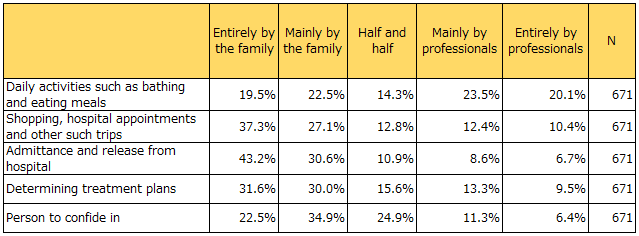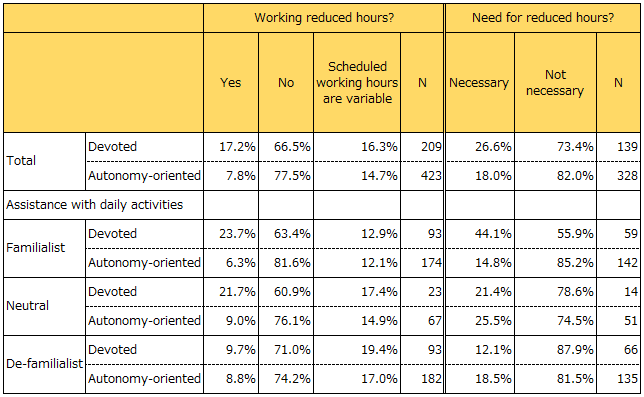JILPT Research Report No.204
Combining Work and Care under the Re-familization of Elderly Care in Japan
March 30, 2020
Summary
Research Objective
The survey investigated trends in leaving jobs due to long-term care commitments and the employment situations of family carers. It is intended to reveal further potential issues with regard to support for combining work with providing care, in light of the revisions to the support system under the 2016 amendment to the Child Care and Family Care Leave Act (implemented in January 2017).
Research Method
Online survey
Survey subjects: Men and women who had experienced providing long-term care of a family member in or after April 2000 and fulfilled one of the following conditions:
- Currently providing care and currently between 20 and 69 years of age, or
- Finished providing care but age at the end of the care period was between 20 and 69
*Includes cases where the care recipient live/lived elsewhere or is/was cared for at a care facility, as opposed to only cases where the carer and care recipient live/lived together.
Survey method
- Extraction: Samples were extracted in a manner that satisfies prescribed collection requirements from monitors registered with a survey company, and responses were requested until the prescribed number of responses had been collected. In addition, screening was conducted to ascertain the attributes of subjects for this purpose.
- Distribution and collection of questionnaires: Respondents completed the survey online using a browser or similar format.
Number of collected responses: 4,000
Main Findings
- Curbing effects of support for combining work with care and flexible working arrangement on tendency to leave jobs: If the correlation with the legally prescribed support system for combining work with care is controlled, the family care leave system has a significant curbing effect on the tendency to quit jobs.
- Extent to which the amended Child Care and Family Care Leave Act has become recognized: Carers who are aware of the amendment are not likely to leave their jobs in the future. However, the degree of awareness of the amendment is relatively low, and there is no widespread understanding of the systems of time off, reduced scheduled working hours, and exemption from unscheduled work.
- Demand for reduced scheduled working hours: The system to reduce scheduled working hours and exemptions from unscheduled work are based on the thinking that it is preferable that family members provide care for the day-to-day activities such as bathing, eating meals, and using the toilet (Table 1). However, there is a growing trend toward emphasizing the autonomy of the care recipient which has seen a decline in demand for such measures (Table 2).
Table 1. The preferable division of care roles between family and external professionals (all employees)

Table 2. Reduced scheduled working hours and the demand for reduced scheduled working hours by involvement with the care recipient
(by opinion on roles of family and external professionals in providing care)

Familialist: Assistance with daily activities provided “entirely by the family” and “mainly by the family.” De-familialist: Assistance with daily activities provided “entirely by professionals” and “mainly by professionals.” Neutral: Assistance with daily activities provided “half and half”(half by the family, half by professional services). Devoted: I provide all means of assistance to ensure that the care recipient feels no discomfort. Autonomous-oriented: I provide as little assistance as possible and allow the care recipient to do what they can themselves. The figures for the necessity of reduced scheduled working hours are responses from those “not working reduced hours” and those who responded “scheduled working hours are variable.”
- Working carers’ wellbeing and inclination to leave jobs: The trends differ among currently employed carers between those who responded that they are “unable to continue” working and those who responded that they “do not know” whether they wish to leave their jobs. Those who respond “do not know” have issues such as a tendency toward depression or having no one to confide in.
- Marital status and likelihood of job continuation: In the case of people who have a spouse, likelihood of job continuation is affected by their relationship with the care recipient, their ability to consult with family or relatives and their workplace having an environment conducive to talking about private matters. In the case of people who do not have a spouse, likelihood to of job continuation is affected by whether they have access to care services that fit with their working hours, and whether there are other people who are able to do their work.
- Negative impact on marriage among young carers: There is a significant decrease in the likelihood of marrying among women who start to provide care in their thirties and forties. Use of care facilities has a significantly positive influence on likelihood to marry among both men and women.
Policy Implications
Support for combining work with providing care can be divided into the tangible—such as managing working hours (time off, leave, changing working hours), long-term care services (in the home or at care facilities), health management, and financial support—and the intangible—that is, human relationships with that working carers receive not only tangible support but also these intangible forms of support in order to ensure that they are able to combine providing care with work and do not leave their jobs due to their care commitments. Efforts to develop the tangible forms of support will become ever more in earnest as the numbers of single carers rise. However, it will be necessary to engage in detailed studies on ways of providing effective support that combines tangible and intangible aspects in case labor shortages and financial constraints will prevent such improvements to tangible support.
Policy Contribution
The survey can serve as a basic reference when studying policies for supporting balancing work and care, such as when reviewing the Child Care and Family Care Leave Act.
Contents (available only in Japanese)
- JILPT Research Report No.204 Whole Text (PDF: 2.8MB)
- Cover – Preface – Authors – Contents (PDF: 341KB)
- Introduction: Outline of the Study
Chapter 1: Curbing effects of support for combining work with care on tendency to leave jobs
Chapter 2: Awareness of the amended Child Care and Family Care Leave Act (2016)
Chapter 3: Involvement with the care recipient and the necessity of reduced working hours (PDF: 1.2MB) - Chapter 4: Working carers’ wellbeing and inclination to leave jobs: The attitude of carers toward balancing work and care
Chapter 5: Marital status and likelihood of job continuation
Chapter 6: Negative impact on marriage and their careers among young carers
Final chapter Implications (PDF: 1.4MB) - Appendix: List of questions for the “Survey on Work and Long-term Family Care” (PDF: 439KB)
If it takes too long to download the whole text, please access each file separately.
Research Categories
Project research: Research on Worker and Corporate Behavior Strategies amid “Work Style Reform”
Sub-theme: Research on Employment and Safety Nets during Child Care and Nursing Care
Research Period
April 2017 -March 2019
Authors
- IKEDA Shingou
- Senior Researcher, Japan Institute for Labour Policy and Training
- NIIMI Yoko
- Professor, Doshisha University
- YAMAGUCHI Mai
- Professor, Japan Lutheran College
- OOKAZE Kaoru
- Associate Professor, Ochanomizu University
- ZHOU Yanfei
- Senior Researcher, Japan Institute for Labour Policy and Training
Catergory
Workers' life / Workers' awareness, Labor laws / Working rules
Related Research Results
- IKEDA, Shingou, 2021, “The Necessity of Reduced Working Hours under the Re-familization of Elderly Care (PDF:983KB),” Japan Labor Issues, vol.5, no.30, April-May 2021
- Research Report No.73 “For Expanded Use of Family Care Leave System” (PDF:103KB) (2006)
- Research Report No.170 “Combining Work and Care” (2015)
- Research Series No. 153 “Survey on Family Caregiversʼ Employment Status and Job Leaving” (2016)
- Research Series No.200 “Survey on Work and Long-term Family Care” (2020)
JILPT Research Report at a Glance
| To view PDF files, you will need Adobe Acrobat Reader Software installed on your computer.The Adobe Acrobat Reader can be downloaded from this banner. |

